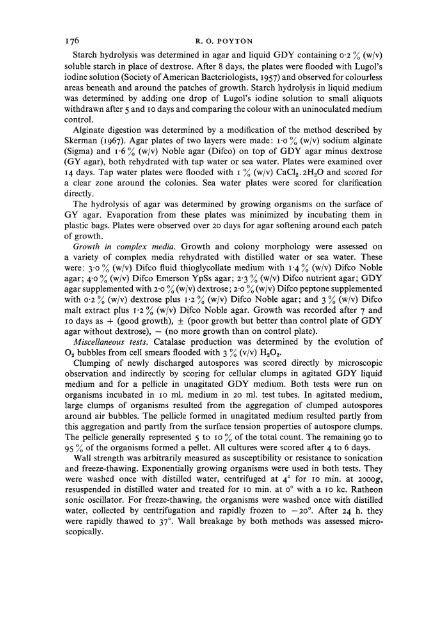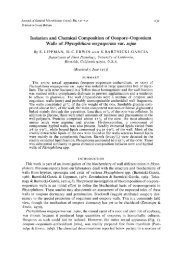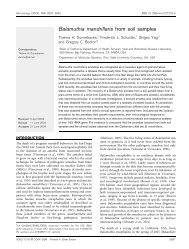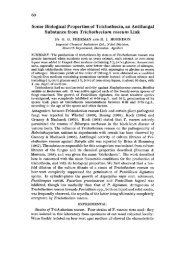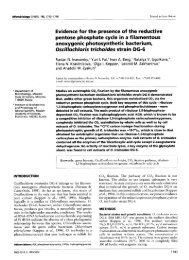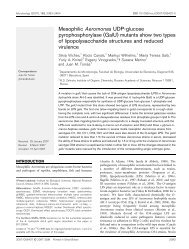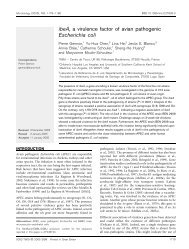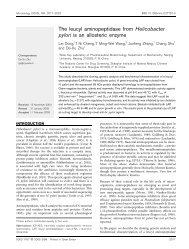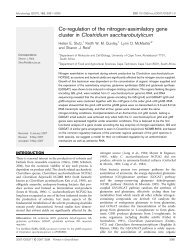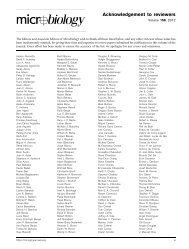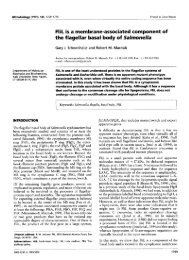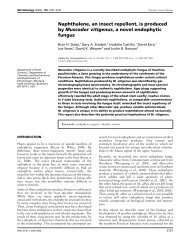The Characterization of Hyalochlorella marina gen. et ... - Microbiology
The Characterization of Hyalochlorella marina gen. et ... - Microbiology
The Characterization of Hyalochlorella marina gen. et ... - Microbiology
Create successful ePaper yourself
Turn your PDF publications into a flip-book with our unique Google optimized e-Paper software.
176 R. 0. POYTON<br />
Starch hydrolysis was d<strong>et</strong>ermined in agar and liquid GDY containing 0.2 % (w/v)<br />
soluble starch in place <strong>of</strong> dextrose. After 8 days, the plates were flooded with Lugol's<br />
iodine solution (Soci<strong>et</strong>y <strong>of</strong> American Bacteriologists, 1957) and observed for colourless<br />
areas beneath and around the patches <strong>of</strong> growth. Starch hydrolysis in liquid medium<br />
was d<strong>et</strong>ermined by adding one drop <strong>of</strong> Lugol's iodine solution to small aliquots<br />
withdrawn after 5 and 10 days and comparing the colour with an uninoculated medium<br />
control.<br />
Alginate digestion was d<strong>et</strong>ermined by a modification <strong>of</strong> the m<strong>et</strong>hod described by<br />
Skerman (1967). Agar plates <strong>of</strong> two layers were made: 1.0 % (w/v) sodium alginate<br />
(Sigma) and 1-6 % (w/v) Noble agar (Difco) on top <strong>of</strong> GDY agar minus dextrose<br />
(GY agar), both rehydrated with tap water or sea water. Plates were examined over<br />
14 days. Tap water plates were flooded with I % (w/v) CaCl,. 2H,O and scored for<br />
a clear zone around the colonies. Sea water plates were scored for clarification<br />
directly.<br />
<strong>The</strong> hydrolysis <strong>of</strong> agar was d<strong>et</strong>ermined by growing organisms on the surface <strong>of</strong><br />
GY agar. Evaporation from these plates was minimized by incubating them in<br />
plastic bags. Plates were observed over 20 days for agar s<strong>of</strong>tening around each patch<br />
<strong>of</strong> growth.<br />
Growth in complex media. Growth and colony morphology were assessed on<br />
a vari<strong>et</strong>y <strong>of</strong> complex media rehydrated with distilled water or sea water. <strong>The</strong>se<br />
were: 3.0 % (w/v) Difco fluid thioglycollate medium with 1-4 % (w/v) Difco Noble<br />
agar; 4.0 % (w/v) Difco Emerson YpSs agar; 2-3 % (w/v) Difco nutrient agar; GDY<br />
agar supplemented with 2.0 % (w/v) dextrose; 2.0 % (w/v) Difco peptone supplemented<br />
with 0-2 % (w/v) dextrose plus 1-2 % (wlv) Difco Noble agar; and 3 % (w/v) Difco<br />
malt extract plus 1-2 % (w/v) Difco Noble agar. Growth was recorded after 7 and<br />
10 days as + (good growth), & (poor growth but b<strong>et</strong>ter than control plate <strong>of</strong> GDY<br />
agar without dextrose), - (no more growth than on control plate).<br />
Miscellaneous tests. Catalase production was d<strong>et</strong>ermined by the evolution <strong>of</strong><br />
O2 bubbles from cell smears flooded with 3 % (v/v) HzOz.<br />
Clumping <strong>of</strong> newly discharged autospores was scored directly by microscopic<br />
observation and indirectly by scoring for cellular clumps in agitated GDY liquid<br />
medium and for a pellicle in unagitated GDY medium. Both tests were run on<br />
organisms incubated in 10 ml. medium in 20 ml. test tubes. In agitated medium,<br />
large clumps <strong>of</strong> organisms resulted from the aggregation <strong>of</strong> clumped autospores<br />
around air bubbles. <strong>The</strong> pellicle formed in unagitated medium resulted partly from<br />
this aggregation and partly from the surface tension properties <strong>of</strong> autospore clumps.<br />
<strong>The</strong> pellicle <strong>gen</strong>erally represented 5 to 10 % <strong>of</strong> the total count. <strong>The</strong> remaining go to<br />
95 % <strong>of</strong> the organisms formed a pell<strong>et</strong>. All cultures were scored after 4 to 6 days.<br />
Wall strength was arbitrarily measured as susceptibility or resistance to sonication<br />
and freeze-thawing. Exponentially growing organisms were used in both tests. <strong>The</strong>y<br />
were washed once with distilled water, centrifuged at 4" for 10 min. at 20008,<br />
resuspended in distilled water and treated for 10 min. at oo with a 10 kc. Ratheon<br />
sonic oscillator. For freeze-thawing, the organisms were washed once with distilled<br />
water, collected by centrifugation and rapidly frozen to -20'. After 24 h. they<br />
were rapidly thawed to 37". Wall breakage by both m<strong>et</strong>hods was assessed micro-<br />
scopically.


